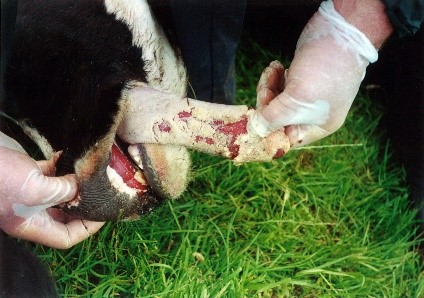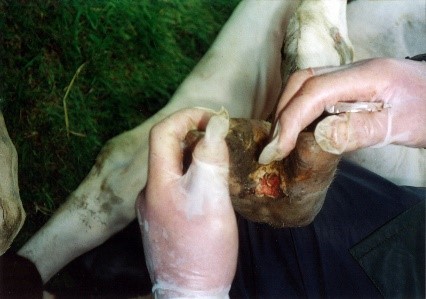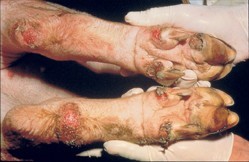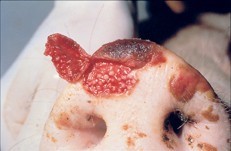What to look for
- fever, drooling and reluctance to move in cattle, pigs, sheep, buffalo, deer, camelids and goats
- blisters on the mouth, snout, tongue, lips or between and above the hooves on the feet; blisters may be intact or ruptured, exposing raw, painful tissue.




The disease causes blisters on the mouth, snout, tongue, lips and between and above the hooves on the feet
Profile
Foot and mouth disease is a highly contagious viral disease that affects cloven-hoofed animals including buffalo, pigs, cattle, sheep, deer, camelids and goats. It is capable of extremely rapid spread – often, entire herds can be infected within 48 hours. Cattle are most susceptible, though pigs spread the disease fastest. An incursion of this disease into Australia would lead to a loss in production of meat and milk, cessation of trade and the slaughter of many animals.
Identification
Early signs include fever, drooling and a reluctance to move. Blisters appear on the mouth, snout, tongue, lips or between and above the hooves on the feet. The blisters rupture to expose raw, painful tissue.
Distribution
Outbreaks are common in parts of Africa, the Middle East, Asia and South America. Outbreaks of foot and mouth disease in the United Kingdom in 2001 and 2007 resulted in millions of animals being destroyed and billions of dollars of revenue lost.
Threat
Foot and mouth disease is considered one of Australia’s biggest biosecurity risks. An uncontrolled outbreak could lead to beef, lamb and pork export markets being closed for more than a year, and control costs have been estimated at more than 50 billion dollars over 10 years . Even an isolated, rapidly controlled outbreak could cost several billion dollars to eradicate, with serious economic and social effects in other sectors, including tourism.
Keep a Top Watch!
Foot and mouth disease virus is carried by live cloven-hoofed animals and in meat and dairy products, as well as in soil, bones, untreated hides, vehicles and equipment used with these animals. It can survive in frozen, chilled and freeze-dried foods including meat and dairy products. It is illegal to carry such items into Australia without an import permit. Keep a watch for planes or boats in your region that may be carrying animals or animal products. Also keep watch for food and garbage washed up on the beach. If you see any of these threats, contact NAQS immediately.
Report any signs of blisters on the feet and mouth of wild and domestic pigs, cattle, deer, goats and buffalo in northern Australia by calling the Emergency Animal Disease Hotline on 1800 675 888.
Moving goods to, from or within Torres Strait?
- Do not move live animals, meat and dairy products, untanned hides or skins, other animal products or soil out of the Torres Strait Protected Zone to the Torres Strait Permanent Biosecurity Monitoring Zone, or from either zone to mainland Australia without a permit and an inspection by a departmental biosecurity officer.
- Report any of these signs in cattle, pigs, sheep, buffalo, deer, camelids and goats to the Emergency Animal Disease Hotline on 1800 675 888

For further information or advice contact NAQS.
